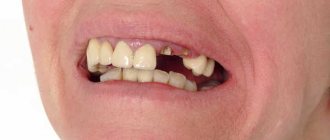Is it painful to remove a nerve from a tooth?
If the form of caries is already advanced, and there are mechanical injuries to the teeth in the oral cavity, then in order to carry out a full range of treatment, the dental nerve itself will have to be removed. Not so long ago, this procedure was considered quite painful; it was for this reason that a visit to the dentist for such a problem was delayed for a very long period of time. Now this procedure occurs with maximum convenience and comfort for the sick patient. But will a dental patient feel pain during pulp amputation?
How can you kill a nerve in a tooth and how do dentists do it?
You should immediately prepare for the fact that one visit to the clinic will not solve the problem. If there are no concomitant diseases and the general condition of the oral cavity is satisfactory, then you will have to visit the dentist at least twice.
During the first appointment, the doctor cuts down the hard part of the tooth affected by caries. Then he has to kill the nerve in the tooth. To do this, a special paste is placed in the pulp chamber and covered with a temporary filling. All drugs that are used to kill the dental nerve (devitalization) can be divided into two categories: arsenic and arsenic-free. The first ones act aggressively, but quickly, the second ones act slowly, but they are completely harmless to the body.
Special actions during dental nerve removal
If you feel bad when eating cold or hot food, or you have deep caries, as well as other pathological diseases in the tissues of the teeth, then the dentist will prescribe you a comprehensive treatment of pulp fibers. This process is quite difficult; it involves the use of x-ray diagnostics and long-term work on dental tissues, which sometimes lasts more than one session with dentists. In modern dentistry, there are two main ways to remove an inflamed nerve.
- In two sessions, using healing pads that will help kill the tissue, after which the dentist will be able to comprehensively remove dead or rotten tissue.
- In one session using anesthesia or, in special cases, without it at all. At this time, the nerve is removed while still alive, then treatment is carried out, as well as filling the canal immediately after it.
These methods of removing a diseased nerve are used both in the case of treatment of molars and for the treatment of milk teeth.
A specific treatment method is chosen by the attending physician himself, based on a comprehensive examination of the patient, as well as the collected medical history of each patient. Since the nerve is considered the most sensitive part of the teeth, pain can occur not only throughout the entire duration of its treatment, but even during exposure of these tissues. To eliminate pain and discomfort, it will be optimal to use specialized application preparations, solutions, and sprays . In this case, absolutely all procedures will be completed quickly and painlessly .
Will the patient experience pain during nerve removal under anesthesia?
Several types of anesthesia may be used during the nerve removal process:
- General.
- Local (gels, ointments, as well as additional injections).
Most often, dentists use only local anesthesia . Thus, it helps relieve the patient from pain and at the same time maintain contact with the patient for better treatment. In addition to all this, it is this type of painkillers that will help keep tissues not affected by infection completely alive , which is almost never possible to do when using arsenic-based pastes and pads.
When using
local anesthesia, which includes lidocaine and other substances similar in composition, the process of complete tissue death occurs, and any manipulations of the attending physician remain completely invisible to the patient .
During the entire procedure of removing a diseased nerve, a person feels only a mechanical effect on the tooth, but does not feel any discomfort or pain at all. If its sensitivity indicator, even when using a large dose of the treating drug, is too high, then the patient may be prescribed general anesthesia . With this approach, throughout the entire treatment procedure the patient is in an unconscious state, as a result of which he does not feel any pain at all. In this case, the patient will not feel absolutely anything even during the process of administering the drug and additional treatment of the canals.
With all this, this type of pain relief is considered the most unsafe for the condition of the patient’s body and is used very rarely . It is mainly used when it is necessary to treat several teeth at once with extremely advanced caries with special complications.
It happens that the patient’s body responds to the healing effects of the drug. Pain is not felt at all during removal at this time. In this case, the dentist most often chooses treatment using arsenic . Arsenic will help remove the nerve in just a few hours without much harm to the body, and will also remove minimal discomfort.
Is it painful to remove a nerve after arsenic?
This procedure is used when the nerve is damaged and there is no way to fully treat it. In this case, the tooth is treated in several stages:
- For the first time, the canal is opened, and the cavity is carefully processed.
- Arsenic or a gasket with another drug is placed in the canal, which will help destroy the nerve.
- The dental cavity is closed using a temporary filling.
- After several days, the filling is removed, and the remains of dead nerve tissue are simply removed.
- After this treatment, the canals should be disinfected with antiseptics, and a permanent filling should be installed on them.
Since already after 2-3 days after the start of treatment the specialist will have to work with dead dental tissues, the procedure for removing them does not cause much pain or discomfort. But at the same time, the patient may still experience some degree of pain. To avoid them completely, the dentist recommends using local anesthesia during the procedure in the form of sprays or gels with arsenic .
Anesthesia can completely remove the sensitivity of the tooth and give him the opportunity to perform such an operation completely without any pain. Sometimes the nerve, due to an error on the part of the dentist, does not die during such treatment. In this case, removing it again will be much more painful. To relieve pain and discomfort, it is necessary to use local anesthesia. The decision to use such drugs can be made by the attending physician himself after examining the patient’s oral cavity.
Is it possible to remove a nerve without using anesthesia?
If a person individually does not tolerate any types of anesthetics, then the dentist can remove the nerve without using them. Will there be any pain in this case? If the patient’s nerve is already dead, then the patient will not even notice any pain, only slight discomfort will arise during treatment of the main canal. If the nerve is still alive, then such a procedure, of course, will be perceived quite painfully. And how sick she will be depends directly on the sensitivity threshold of the patient himself. The higher its indicator, the more painful and painful the procedure to remove the diseased nerve will be.
Ultimately, even with nerve amputation without the use of anesthesia, as well as with treatment using drugs, everything can be done as efficiently and painlessly as possible for the sick patient. In order to avoid absolutely any pain during such a procedure, the dentist must very carefully and carefully examine the condition of the tooth, as well as the patient’s sensitivity to various types of drugs that relieve it. And only after all these manipulations, the dentist must choose the most suitable treatment method in each case. It is in this situation that the depulpation of the nerve will occur quickly and comfortably for the patient.
The main steps in preparing for the nerve removal procedure
- Carrying out radiography . It is used, for example, when a doctor has any doubts when diagnosing a patient. If there are certain suspicions that the nerve in the dental canals has died, then most often intraoral contact radiography or a visiography image is used, which is much safer than the first action.
- General anesthesia . Most often, local anesthesia is used, but as stated earlier, in certain cases and the wishes of patients, the removal process can be combined with the use of anesthesia when the patient completely loses consciousness (this anesthesia is especially common in relation to young children). When using local anesthesia to remove the nerve, special techniques and anesthetics should be used that will help quickly and effectively freeze the tissue around the tooth, almost completely cutting off its ability to feel for some time.
- Isolation of the working field . In private clinics with expensive treatment, teeth should be covered with rubber - this is a specialized latex film that protects the diseased tooth from saliva getting into it, and, in addition, can create the most comfortable treatment conditions for the dentist.
- Treatment of carious tissue around the tooth using air-water cooling , creating convenient access to the pulp chamber, opening the chamber and creating smooth walls.
Self-removal
Against the backdrop of severe psychological trauma received in childhood, usually in a regional Soviet dental clinic, many people try to remove a nerve or tooth on their own. Such actions pose a real threat to health and life. Due to psychological trauma, any procedure seems much more painful, and the person decides to die rather than go to the dentist again.
In this case, folk remedies suggest applying garlic, cotton wool with alkali, ammonia or acid to the sore tooth. In this case, the patient hopes to kill the nerve so that the doctor can then painlessly remove it. This is a kind of replacement for the Soviet method of exposure to arsenic. It is unnecessary to say that this is useless and extremely dangerous. Acids and alkalis burn the gum mucosa and tooth enamel, but they are unlikely to reach the nerve itself.
Read also: Alveolitis after wisdom tooth removal
As for self-removal using a thread tied to the door and tooth, pliers or knocking out the teeth with a nail and hammer, such methods can more likely break the jaw and seriously injure a person. Removal should only be carried out by a surgeon after examination by the attending dentist. We are not joking now; cases of such removal occur in our time.
Modern dentistry has made the procedure painless. And all other therapeutic measures are carried out under the influence of safe but effective painkillers. You need to understand this and realize the fact that every month, not even a year, new techniques, drugs and materials are introduced in dental clinics. Dental fillings and dentures have become indistinguishable from real teeth. It is becoming unfashionable to flaunt gold or zirconium crowns. The sooner you go to the doctor, the faster and more effective the treatment will be, the tooth will be saved, and you will not have to study this topic anymore.
Arsenic in modern dental practice
When caries, periodontitis, and pulpitis begin to develop in the oral cavity, the dental nerve becomes sensitive to food of different temperatures and tastes.
The pain occurs suddenly, is throbbing or aching in nature, and in the case of advanced diseases persists for a long time. To get rid of unpleasant symptoms, it is necessary to remove the pulp. Removal can be complete or partial. The nature of the operation is determined after examination by the dentist. Before the procedure, the pulp is killed with arsenic. Arsenic has immunotoxic properties and has a necrotic effect on the nerve. Pulp cells die due to interruption of blood supply. The death of nerve endings leads to the disappearance of pain. By its nature, arsenic is a strong poison (a dangerous dose is 50 mg), but in dental practice it is used as part of multicomponent pastes.
The paste contains:
- arsenic anhydride;
- tannin;
- anesthetic (lidocaine, novocaine);
- antiseptic (camphor, thymol);
- binders;
- filler to obtain the desired volume.
The nerve removal procedure includes the following steps:
- Treatment of carious cavity under local anesthesia.
- Opening the pulp horn, drying the cavity. Applying paste to the nerve.
- Applying a pad with medicine and a dry tampon. Installation of a temporary filling.
- Removal of temporary fillings and tampons (after a few days - from 1 to 7 depending on the concentration of arsenic and the number of roots of the tooth).
- Pulp sensitivity test.
- Preparation of a carious cavity and removal of a dead nerve.
- Cleansing and expansion of channels. Place a gasket on the bottom of the cavity for insulation.
- Restoring a damaged tooth using a permanent filling.
The dose of arsenic used during dental procedures does not have a negative effect on the body. To make the procedure safer, you need to respect the time the paste is kept in the tooth, since if the paste is overexposed, there is a risk of tooth destruction - it will have to be removed.
Dental treatment with arsenic
Despite the fact that this is the twenty-first century, today doctors continue to resort to arsenic to remove the dental nerve. Previously, this was the only way to remove the nerve; today it is used in cases where other methods are not effective.
We invite you to familiarize yourself with the Causes of excessive salivation in men and women
In fact, the procedure for removing a nerve using arsenic is quite unpleasant and even painful. In addition, one visit to the dental office will not be enough.
The first appointment involves expanding the pulp cavity, opening it, applying a special paste containing arsenic, and placing a temporary filling. Arsenic may take several hours to several days to kill a nerve. Overexposure to arsenic can lead to the development of periodontitis.
The second dentist appointment involves removing the pulp, cleaning the canals, sealing them and restoring the tooth. As has already been said, a tooth without a nerve is considered dead, so even when filled, it remains fragile.
Indications for use of arsenic paste
Killing the pulp with arsenic paste is carried out in the following cases:
- Having allergies to other medications.
- Lack of time for full treatment.
- Pulp bleeding. Bleeding may be caused by increased blood pressure or the beginning of the menstrual cycle. This creates difficulties in finding and filling canals that cannot be left unprotected.
- Treatment of a baby tooth.
- Contacting the dentist on duty with toothache at night.
- sensitivity to paste ingredients;
- age up to one and a half years;
- insufficient formation of tooth roots;
- impossibility of high-quality cleaning of channels due to their curvature or overlap;
- presence of root separation;
- increased intraocular pressure;
- kidney and prostate diseases;
- pregnancy and lactation period.
Use of arsenic
Allows you to painlessly remove pulp and nerve tissue - an outdated, but still used method - applying arsenic paste to the desired location. To do this, the tooth is drilled out with a drill, a medicinal preparation with this component is placed in its cavity, and a temporary filling is placed on top. After 2-3 days, a second visit is necessary, during which the tissue destroyed by arsenic is removed and the canals are filled.
The disadvantages of the method include:
- a certain danger of the procedure, since it uses a toxic substance;
- possible damage to healthy tooth tissue;
- the risk that the nerve will not be killed completely.
Modern anesthesia is one step ahead of depulping with arsenic, but sometimes this method is the only suitable method for treating a tooth. Then the dentist resorts to the safest medications possible - Devit-Ars, Palpursen, Septodont, etc. In addition, arsenic-free paste is also likely to be applied.
Read also: What to do when a tooth is pulled out The question often arises: how to relieve toothache at home? See useful information in our material.
Read about how to make your teeth white at home here.
How long does arsenic stay in a tooth?
The length of time the drug remains in the tooth is determined by the doctor. It depends on:
- the amount of arsenic in the paste;
- patient's age.
- tooth structure.
To treat baby teeth, 18 hours of exposure to the drug is sufficient. The solid paste of Kaustinerv arsenic is kept for a week, and Kaustinerv fast-acting - up to 3 days.
It is not allowed to increase the established time of wearing arsenic. Long-term exposure can adversely affect tissue, causing necrosis of bone tissue, gums and alveolar bone. Other consequences are also possible:
- darkening of dentin;
- periodontitis;
- inflammatory swelling of the pulp;
- intoxication of the body.
Painful sensations when arsenic is applied can persist for about three hours after the procedure. To reduce discomfort, you are allowed to rinse your mouth with soda solution and take painkillers.
Causes of pain after applying and removing arsenic:
- insufficient amount of paste;
- violation of the terms of wearing a temporary filling;
- necrosis of the gums or bone tissue;
- sealing error (installation of a tight seal);
- late visit to the dentist (in case of development of an abscess or phlegmon);
- allergic reaction to the components of the paste.
To reduce the risk of complications after the procedure, the following rules must be followed:
- Do not eat or drink for two hours. At this time, the paste hardens; without hardening, arsenic enters the oral cavity.
- If the drug falls out, you need to rinse your mouth with a soda solution, which neutralizes the effects of arsenic and protects the oral mucosa from burns.
- Do not leave the product in the tooth. Be sure to visit the dentist after the specified time.
Pregnant women and children: treatment features
Is it possible to put arsenic in a tooth during pregnancy? The effect of the substance on the fetus and the likelihood of complications have not been fully studied, but it is known that the drug severely destroys the tooth itself and its walls, and in women who are pregnant due to weakened immunity, lack of vitamins and hormonal changes, treatment can negatively affect the teeth.
On a note! Even at the stage of pregnancy planning, it is important for a woman to solve all her dental problems, but if pulpitis occurs during pregnancy, then treatment is best carried out in the second trimester.
For these purposes, devitalizing pastes without arsenic are used, but similar in their effect. For example, paraformaldehyde paste or drugs “Devit-S”, “Devit-P”, “Devit-A”, which are safe for health.
These drugs are also suitable for the treatment of baby teeth.
As for children, there are several dangerous aspects that make doctors afraid to use it even after reaching the age of three: it is difficult to calculate the dosage of the drug, the baby can easily damage the temporary filling and swallow the substance - all this will lead to intoxication of the body. In addition, the dentin of baby teeth is very fragile, so when using the drug there is always a chance that the tooth itself will collapse very quickly.
Won't it hurt? Removal of pulp “killed” by arsenic
Removing pulp “killed” by arsenic does not hurt at all. When exposed to the paste, the nerve stops receiving signals, and the blood flow in it stops. To prevent pain during the procedure, additional local anesthesia is used.
Discomfort in the tooth after nerve removal can be of a different nature. Factors influencing the occurrence of pain:
- Foreign interference in the oral cavity. In this case, the pain is pulsating and appears when there is physical impact on the tooth: pressing, chewing food, closing the jaws. The pain goes away after a few days; if the discomfort is severe, you can take painkillers.
- Incorrect treatment. Painful sensations appear due to poor cleaning of the canals or incomplete removal of the nerve.
What can and cannot be done after the procedure?
After the procedure, each doctor will give the patient individual recommendations. General tips include the following:
- do not exercise for the first 2 hours;
- you should not eat food for 3 hours after extraction, so as not to cause infection or injure the tooth;
- avoid eating solid foods for 3–5 days;
- do not drink alcohol or smoke (to avoid irritation of the mucous membranes);
- perform the procedure of rinsing with antiseptics within 24 hours after removing the nerve.
If the patient feels discomfort or pain for several days, you should consult your doctor.
Reasons for nerve removal
In what cases is a nerve removed from a tooth? This must be done when it is affected by serious caries that has reached the soft tissues. Usually in such a situation a person feels pain. It becomes stronger if he eats sweet, hot, sour, that is, some irritating foods and liquids.
The carious process has a destructive effect on the enamel, resulting in the formation of a cavity in the tooth. Various bacteria easily penetrate into it, which begin to affect the dense dentin and the pulp itself. When inflammation reaches the pulp, the nerve must be removed. Of course, with such inflammation it is difficult to avoid pain. This is due to the fact that bacteria damage tissue, which begins to swell in response to their negative influence. As a result of the formation of a tumor, the endings of the nerves are compressed, so they begin to hurt. Removing the nerve in this case will only alleviate the patient’s condition, relieving him of unbearable toothache.
Nerve removal is also carried out in other cases:
- mechanical tooth destruction;
- formation of a large caries cavity;
- frequent pain.
Modern pulp removal technique
Don't be afraid of the dental office. In modern conditions, the patient will not feel pain either during the procedure or after it.
Initially, the doctor will inject an anesthetic drug into the gum, wait for the working area to become numb, and then use a special drill to prepare the carious dentin. This opens up access to the nerve.
When the passage is open, using a thin, string-like instrument, the pulp will be pulled out, and at the end, all the channels and passages will be sealed. At the final stage, a filling is placed on the crown of the tooth.
There is a technique for partial removal of the dental nerve. If in the first case the tooth is considered dead, then in this way it will remain viable.
However, it is performed only when the upper part of the tooth is affected, when the process has not penetrated deeper. The doctor opens the crown of the tooth, cleans the affected areas and cuts off the upper part of the pulp.
Arsenic removal is not dangerous, but unpleasant
The damaged nerve is removed using different methods. One of them is the use of arsenic. Those who are expecting just such a procedure are wondering whether it hurts to remove a nerve from a tooth after arsenic? As a consolation to them, it should be noted that this remedy is precisely used to make the nerve die, because otherwise the pain will be wild. Thanks to arsenic and an anesthetic that the dentist can inject at the patient's request, the procedure will most likely be completely painless, although it will still be unpleasant. Any trip to the dentist is unpleasant for most people.
Arsenic is usually used when the nerve cannot be removed immediately by other methods. Usually the procedure lasts for 2 appointments. First, the dentist, using a drill without a drill, makes the pulp cavity wider, and then applies a paste with arsenic. After this, a temporary filling is installed, thanks to which the paste stays in place. The nerve may die within a few hours, although sometimes it may take several days.
Problems when installing a filling with arsenic
You cannot overexpose a filling with arsenic. The timing is set by the attending physician. Many people make a big mistake when the pain subsides and do not rush to see a doctor. It's in vain. Paste containing arsenic can cause tissue cell death. If the filling is applied poorly, necrosis may occur:
- Bone tissue.
- Gums.
- Alveolar bone.
If the filling is accidentally displaced, it can result in a serious gum burn from arsenic acid. In this case, you should urgently take hydrogen peroxide and rinse the affected area, then sprinkle with magnesium. To prevent arsenic from affecting the gums, first lubricate it with iodine tincture.
Remember! Under no circumstances should you keep arsenic in your teeth, otherwise the pulp may become very swollen or you will be seriously poisoned. Sometimes an overdose of arsenic leads to acute periodontitis. In this situation, the root and coronal pulp are immediately removed, then the root canals are thoroughly disinfected.
Removal with anesthesia - almost invisible
Another method of nerve removal is based on the use of anesthesia. Is it painful to remove a nerve from a tooth under anesthesia? It is used to relieve the patient from pain. One of 2 types of anesthesia is used - local or general.
In most cases, local anesthesia is used, as it relieves the person from pain, but the doctor can communicate with the patient if necessary. Thanks to this type of anesthesia, tissues that have not been affected by infection are kept alive, which is not the case with the use of arsenic. With local anesthesia, the tissues are completely numb, so the person does not feel pain, in principle, he does not feel anything in the area where the anesthetic acts. He can only feel mechanical pressure on the dental element, but there is nothing to worry about.
In some cases, even when using high-quality local anesthesia in large doses, the sensitivity of tissues and nerves remains. This is an indication for the use of general anesthesia. It can also be used if a person is simply terrified of the procedure. Thanks to general anesthesia, the patient is unconscious and does not feel anything, which allows the doctor to work calmly. Of course, general anesthesia is harmful to the body, so it is used only in extreme situations, for example, when you need to treat several teeth affected by caries.
Useful tips
After the nerve is removed, as the anesthesia wears off, the person may feel pain. How to calm her down? A solution of salt and iodine helps a lot. In a glass of boiled water you need to add 5 drops of iodine and 1 tsp. salt. They should rinse their mouth, holding it for some time near the tooth that was manipulated. At first you can do this every hour.
Among folk methods, rinsing with alcoholic drinks, for example, cognac, vodka, is common, and after rinsing they need to be spat out. The gum of a diseased tooth can be covered with propolis. You can also use painkillers.
Is it painful to remove a tooth nerve after arsenic?
The appointment is conducted by doctors:
Borodulina Nina Vladimirovna
Kozaeva Veronika Tamerlanovna
Dentist-therapist, children's therapist
Kalaichev Alexey Demosthenovich
Andreischeva Margarita Igorevna
Removing the nerve of a tooth is always a necessary measure if it is no longer possible to save it. Previously, dentists used arsenic, which gradually killed the nerve endings of the tooth. But this method is practically not used due to the use of more modern methods.
Installation of dental crowns - to remove the nerve or not?
The human tooth has a complex structure. You might think that a tooth is only a visible part - a bone, but this is only partly true.
The top layer is covered with enamel, which hides dentin and pulp, which runs along the entire root, going deep into the gum. The pulp has a loose fibrous-vascular structure, and is popularly called the nerve of the tooth.
This element reacts to thermal stimuli: sour, hot, salty, cold. If during a dental procedure the doctor decides to remove the pulp, the tooth automatically loses its blood supply and is no longer alive.
The mineralization process also stops. Next, tooth destruction begins: resistance to external irritants decreases, the enamel becomes thinner and darkens.
From the above we can conclude that the pulp plays an important role in metabolic processes and the life of the tooth.
When treating teeth by installing crowns, a person may wonder whether it is necessary to remove the nerve of the tooth.
Here, either a positive or negative decision can be made, depending on the initial state of the oral cavity. If the tooth is almost completely destroyed, then removal of the nerve is mandatory.
The qualifications and practical experience of the attending physician play an important role in this matter. Before installing metal-ceramic crowns, the tooth surface is prepared (filed).
If the doctor is inexperienced, then when heating or deeply removing the surface layer, the nerve may be affected, which will lead to an attack of acute pain, so it is better to remove it.
In addition, with this method of treatment, there is a high probability that over time the tooth will begin to hurt under the crown and then it will be more difficult to remove it.
If the procedure for removing the nerve of a tooth is performed by an unqualified specialist or with little practical experience, there is a risk of complications.
The most common are:
- bleeding from the canal;
- recurrent pain;
- part of the instrument breaks off and remains in the canal.
Bleeding can occur during any medical procedure. Doctors often quickly deal with this complication and stop the bleeding.
When the procedure is completed and the patient is already at home, he may feel twinges of pain. It's normal if it doesn't last for a long time. If it lasts for a long time, the canal will need to be re-opened and disinfected.
Broken file or pulp extractor is a complex but rare problem. This happens due to inept handling or poor quality tools. In such a situation, the doctor must make every effort to remove it from the canal. If this is not done, then attacks of acute pain will soon begin and the tooth will have to be removed completely.
We invite you to read: The most frequently asked questions about dental implants
How does depulpation occur?
Depulpation is indicated in the following cases:
- for throbbing, persistent pain.
- when caries begins to spread to the root part of the tooth.
- in case of installation of metal-ceramic crowns.
The depulpation procedure occurs painlessly under local anesthesia. There are two methods of tooth depulpation, the first is when the removal of the neurovascular bundle (pulp) occurs under anesthesia simultaneously at the first visit, and the second method is when a paste containing arsenic is applied and the nerve is removed after a few days, when the nerve ceases to be sensitive.
Our doctors:
Borodulina Nina Vladimirovna
Kozaeva Veronika Tamerlanovna
Dentist-therapist, children's therapist
Kalaichev Alexey Demosthenovich
Andreischeva Margarita Igorevna
Painful sensations after nerve removal
After surgery, many people experience aching pain for several days. This is normal, since during the operation the tooth structure is damaged. If the pain becomes severe, you should immediately contact your dentist.
If a sharp pain is felt, this should be the reason for a second visit to the dentist. Such sensations can be caused by poor-quality filling or the spread of inflammation. In addition, the cause of pain can be an allergic reaction to the material used for filling.
Advantages of treatment at the NEW AGE clinic
- Painless injections ensured by applying a special gel to the gums;
- Availability of orthopedic chairs, which are comfortable even during a long operation;
- Availability of highly qualified specialists;
- Possibility of treatment in installments;
- Use only certified instruments and materials for treatment.
Use of arsenic
The use of arsenic is an outdated method, which is used only if the patient cannot tolerate drugs intended for pain relief. It is worth noting that in this case, the removal of the nerve occurs over a long period of time and is associated with unpleasant experiences.
When using arsenic, the doctor clears access to the pulp and then places a paste containing arsenic there. Due to this, the nerve dies within a few days. During subsequent surgery, the patient does not feel pain during removal of the nerve.
The appearance of painful sensations while wearing arsenic and removing the nerve after this can occur in several cases:
- if the dentist placed insufficient amount of paste;
- when the temporary filling is not removed on the appointed day;
- if the canals are filled incorrectly;
- if gum necrosis occurs.
Definition of root canal treatment
To get an accurate idea of the procedure for treating dental tubules, you first need to familiarize yourself with its original structure .
Enamel performs protective functions, since its tissues have a high level of density compared to other coatings in the human body.
In cases when it begins to collapse, this process indicates the initial stage of caries. If you start dental treatment at this stage, the treatment will be easy and painless.
Dentin is the second layer of the tooth , protecting the pulp, but in conditions of penetration of caries in the absence of proper treatment, it is unlikely to withstand the negative influence of the bacterial process.
The pulp is the central part of the tooth, which contains nerves with feeding blood vessels. It should be understood that if this part of the tooth becomes infected, a person begins to experience unbearable pain, which is why a tumor of the gum arch (flux) and cheek may develop.
In this situation, you should not think about whether it is painful to remove the nerve from a tooth, but urgently undergo specialized treatment.
The internal canals of the tooth extend downward from the pulp compartment, within which passes the nerve that connects with the main nerve base.
It follows from this that the canals of the tooth are cavities of the root system of the tooth , in which the dental nerve is located. In a situation where the inflammatory effect is left to its own accord due to which the pus has spread over the surface of the bone, then, as a rule, in-depth therapy of the dental tubules will be required. After which the tooth is depulped (nerve removal).
Contraindications to the procedure
Depulpation (removal of the dental nerve) in dentistry is a necessary measure in dental treatment.
It is rarely possible to do without it in case of injuries and treatment of complicated caries. Modern medicine allows this procedure to be performed quickly and safely for the patient. However, there are complications, including the occurrence of residual inflammation of the dental nerve when it is not completely removed. How justified is the procedure for removing the nerve, and what will happen to the tooth after it? The decision is made by the doctor on an individual basis. It is important to remember that any manipulation is carried out in order to preserve and strengthen the tooth and restore its shape.
Contraindications to depulpation are relative, but if they exist, the doctor tries to preserve the pulp:
- sore throat, ARVI;
- acute stomatitis;
- mental disorders;
- pregnancy (especially 1st and 3rd trimester);
- severe cardiovascular diseases;
- viral hepatitis;
- acute form of tuberculosis.
According to numerous surveys, it is the dentist who instills fear and panic in human hearts. The culprits of this reputation are outdated methods of pain relief, as well as the high sensitivity of tissues and nerves in the oral cavity.
However, modern anesthesia, which completely blocks any discomfort, stands against the myths about the horrors of the dentist’s chair. Therefore, you shouldn’t even think about whether it’s painful to remove a nerve from a tooth - it hasn’t caused any pain for a long time.
Dental treatment, like any other therapy, is carried out in different ways depending on the stage of pulpitis. And the sooner the dentist examines the sore spot, the easier it will be to maintain the vitality of the tooth.
So, one of the types of therapy can be used:
- biological, with maximum preservation of soft tissues;
- vital, with the elimination of fiber only in the coronal part of the tooth;
- surgical, which involves complete removal of the pulp and nerves.
In this case, the dentist usually tries to preserve the connective fiber, since without it the tooth will no longer be supplied with nutrients. This means that over time, its enamel will fade, change color, and after a few years, hard tissues may also become unusable. Therefore, it is very important to contact a dentist in time if there is pain in the tooth area, otherwise it will not be possible to save the pulp.
To treat soft tissues, during the first visit to the doctor (regardless of the chosen therapy option), the following is carried out:
- anesthesia;
- drilling out carious areas;
- isolation from saliva;
- removal of affected tissue;
- installation of temporary fillings.
During surgical depulpation, all the root canals of the tooth are also measured (under X-ray control), and then they are prepared for filling at the next visit to the dentist.
A second visit to the dentist is necessary for more complete therapy and requires:
- removing a temporary filling;
- treating internal cavities with an antiseptic;
- complete filling.
Anesthesia is very important in the matter of dental treatment, since many people delay the treatment of pulpitis precisely out of fear of pain from removal of the nerve and soft tissue.
But today many methods and drugs have been developed that completely relieve unpleasant sensations:
- Anesthetic application. Used for minor work on dental tissues. In addition, it can be used for preliminary anesthesia of the injection area, which will introduce the main local anesthetic drug.
- Infiltration anesthesia. Used for cleaning canals and the internal cavity of the tooth. Medicines are administered by injection intraosseously or into the subperiosteum area. Preferred when treating the upper row of teeth.
- Conduction anesthesia. An excellent method of pain relief during operations to remove soft fibers, allowing you to completely neutralize the nerve branch. The drug is injected directly into the nerve. Suitable for treating several teeth at the same time.
- Ingmentary anesthesia. Used for long and painful treatment procedures. The drug is injected with a syringe into the ligament of the tooth.
- General anesthesia. It is used when the patient has great fear of manipulation or poor perception of local anesthesia.
In addition to the above methods, there is also stem and intraosseous anesthesia, which is used in difficult cases and is not used for the treatment of pulpitis.
A large selection of methods and drugs for anesthesia in the treatment of pulpitis was not created in vain, because the removal of tissue and nerve roots is a painful process.
Without the use of pain relief, this is a real nightmare, which is especially difficult for people with a low pain threshold.
The only option when removing soft tissue without anesthesia does not cause terrible discomfort is that the nerve is already dead by that time.
That is why there are a number of folk methods for eliminating tooth sensitivity:
- vinegar and alcohol lotions;
- adding painkillers (Ketanov, Baralgin, etc.);
- powder seals.
Each of these methods can relieve nerve pain, although mostly temporarily. However, the use of traditional methods is unsafe and does not give a long-term effect. For example, vinegar lotion can burn the mucous membranes of the gums, cheeks, and tongue. Therefore, it is much easier to resort to professional help from a dentist rather than treating pulpitis yourself.
Removing a nerve is a simple and painless procedure that should not be feared. Trouble during its implementation most often arises only through the fault of the dentist, who made a mistake when using anesthesia or during the elimination of soft tissue. Therefore, choosing a good dentist will reduce the risk of painful sensations during dental treatment.
When, as a result of advanced diseases (caries, pulpitis) or tooth injury, the pulp is exposed - the internal tissue braided with nerve fibers, unbearable pain occurs. In order to stop it and treat or restore a dental unit, dentists are often forced to remove the nerve.
The dental nerve is a branched system of nerve filaments, lymphatic ducts and blood capillaries. This system is located in the pores of loose pulp. It connects to the gingival tissues through channels passing inside the dental root processes. In addition to its sensitive function, its purpose also includes the function of delivering nutrients to all layers of the tooth.
Therefore, whenever possible, doctors always try to preserve the pulp along with nerve fibers and other components of the system. After all, without it, the dental unit becomes dead and begins to gradually collapse. The enamel becomes fragile, dull, and acquires a grayish-bluish tint, the brightness of which depends on how intense the destructive processes are in dentin that does not receive nutrients.
Sensitivity to temperatures and other influences in such a tooth is lost. However, with careful hygiene and careful care, it can serve for another 10 years or more. Therefore, removal of the nerve is considered a justified procedure and should not be feared. Moreover, if the patient does not have individual intolerance to the components of painkillers and with competent work of the dentist, the operation is completely painless. There may only be a feeling of slight discomfort.
We suggest you read: After tooth extraction - if the tooth and gums hurt after removal, rules of behavior for preventing complications, what to do after wisdom tooth removal, how many days does it take for the socket to heal?
The pulpectomy procedure is performed in a certain sequence:
- first, if necessary (in advanced, doubtful cases), an x-ray is taken;
- then the surgical site is anesthetized most often through injections of anesthetics into the gums and pulp; in rare cases (usually when treating children), general anesthesia is used;
- the tooth is cleaned by water injection and then dried under an air flow directed at it;
- protected from wetting with saliva using cotton swabs or a special latex plate (cofferdam);
- then it is opened using a drill, the walls of the pulp chamber are leveled;
- and a special disposable dental instrument - a pulp extractor, through rotational movements, or using special universal files (a more modern method), bundles of nerve fibers, blood vessels and lymphatic ducts are extracted;
- then the cleaned, disinfected canals in the roots and the dental cavity are sealed;
- If in a patient who has come to have a nerve removed, the pathological processes have gone far and caused inflammation of the gums, then before closing the tooth with a filling, rinsing with antiseptic solutions is prescribed for several days until the affected tissues are restored.
Removing nerve fibers is unpleasant for the patient, but not painful. Sometimes after local anesthesia, itching may be felt, accompanying the return of sensitivity of the soft tissues of the oral cavity. Or you may be bothered by a slight aching pain for 24 hours while the disturbed gum tissue is restored.
More dangerous symptoms (lumbago, throbbing pain) are possible only if the dentist makes mistakes: injury to the tooth root, infection, incomplete cleaning of the root canals, or a piece of an instrument (pulp extractor) getting stuck in them.
In all these cases, immediate contact with your doctor and elimination of defects is required.
10-15 minutes before pulpectomy, an anesthetic is injected into the gingival tissue in the area of the tooth root and into the pulp. These are the last painful sensations that the patient experiences. Further, all the doctor’s manipulations in the area of the affected tooth occur without pain, but there may be a feeling that they are unpleasantly digging into the dental body, picking at it.
The procedure lasts 20-60 minutes. If in difficult cases it drags on, then the dentist, so that the patient does not feel pain, gives another anesthetic injection. When the doctor doubts whether he has completely removed the remnants of the sensitive and nutritional systems from the root canals, he can put a temporary filling and refer the patient for an x-ray.
Permanent filling is performed only after the dentist is sure that the canals are cleaned properly.
Pain during nerve removal surgery is only possible in the following situations:
- the anesthetic was introduced too far from the location of the nerve structures;
- the anesthetic is of poor quality and does not work or is too weak.
In this case, the doctor needs to make additional, more precise injections or change the drug.
Depulpation with arsenic
Arsenic is a rather outdated method of removing a nerve, but nevertheless it is used in dentistry in some cases.
This procedure is performed over a longer period of time than when all inflammation can be removed in one step with minimal risk of pain.
The whole process is carried out in stages:
- Local anesthesia (if tolerated).
- Opening the cavity.
- Laying arsenic-containing composition.
- Installation of a temporary filling.
- Sending the patient home for 2 - 3 days.
- Removing a temporary filling with dead pulp.
- Cleaning the tubules.
- Installation of a long-term filling.
Please note that arsenic is a poison . Therefore, during this type of treatment, it is important to strictly follow all the dentist’s recommendations - to come at the appointed time to remove arsenic from the dental cavity. Since this is fraught with the death of healthy gum cells.
At the same time, people are afraid to go for treatment, doubting whether there will be pain during the removal procedure. There is an answer to this - pain is not felt when the actions are performed correctly, which does not interfere with removing the nerve and placing a permanent filling.
Pain syndrome is unlikely to appear unless in cases of insufficient volume of arsenic injected internally, when a temporary filling is worn longer than the allotted time, necrosis of tissue around the perimeter of the tooth, or a doctor’s error.
It is important to follow all the dentist’s instructions after completing the temporary filling stage. Namely, do not drink or eat food during the first 2 - 3 hours , as there is a danger of arsenic particles peeling off and penetrating into the human body.
There is no need to think too long about whether or not to remove the nerve, because precious time is wasted. If not treated in a timely manner, you may end up having to remove the entire tooth.
Patient behavior after arsenic application
For a patient who has arsenic in a tooth, it is important to follow some recommendations:
- He cannot eat or drink for 2 hours. This time will allow the filling to harden thoroughly and give the arsenic paste an opportunity to “work” with the nerve. If you start eating and drinking immediately after a visit to the dentist, the filling will crumble and toxic substances will end up in your mouth.
- Components in the form of arsenic in dentistry are completely safe for human health. This method of killing the nerve was previously calmly used even in pediatrics for very young children. And even if it gets into the mouth, arsenic does not pose a clear threat to human life or health, since we are talking about the use of arsenic components, and not a toxic element in its pure form.
- If, nevertheless, the arsenic paste falls out, then you can feel a sour taste in your mouth. In this case, it is recommended to rinse your mouth with a soda solution. This simple remedy neutralizes the effects of the paste components and protects the oral mucosa from burns.
- After the arsenic compound falls out of the tooth cavity, it is useful for the patient to drink 1-2 glasses of milk. This is a proven means of binding toxic compounds and removing them from the body.
- You should not walk with arsenic for more than the period indicated by the dentist. Typically, arsenic paste is used for a period of 1 to 2 days. On single-rooted teeth, the period of application of arsenic is usually limited to one day, and on teeth with several roots, the period of use of the paste is increased to two days.
- A temporary filling can last up to six months. If you miss this deadline, the arsenic in the tooth and the toxic substance from the diseased canal will begin to destroy neighboring healthy teeth. The extreme critical retention period for arsenic is up to 7 days.
After applying arsenic, it is important to strictly adhere to the deadline for the next visit to the doctor. The tooth will soon stop hurting, but under no circumstances should you reschedule a visit to the doctor on your own.
Arsenic during pregnancy and in pediatric dentistry
There are 3 risk groups that need to think about whether it is dangerous to treat teeth with arsenic.
These include:
- Pregnant women.
- Intrauterine fetus.
- Children.
Pregnancy is a special period in a woman’s life when responsibility comes not only for her own life, but also for the life of the unborn child.
Therefore, treatment with arsenic-containing medications is highly not recommended during pregnancy and throughout the entire period of breastfeeding. Despite the fact that the composition is applied in a small dose, there is a negative possibility of toxic fragments of arsenic entering the fetus through the placenta. Because of this, it is imperative to warn the treating dentist about the state of pregnancy.
It should be remembered that modern dentistry has the necessary number of harmless products without harmful arsenic to kill and remove the nerve without causing harm to the mother and child.
Treatment with arsenic for children is carried out in the same way as for adults only when an allergic reaction occurs.
The use of a devitalizing mass is also recommended when a child has a strong fear of injectable anesthetics.
At the same time, it is important to note that nerve paralysis using arsenic can only be carried out in conditions of fully developed roots , that is, this procedure is unlikely to be performed for young children (limited to 1.5 years).
If this condition is violated, there is a threat of periodontitis formation.
Restrictions on the use of arsenic for children
Many people are concerned about the question of whether the time period for placing arsenic is different for an adult and a child. The answer is that children need to remove arsenic after 16 to a maximum of 24 hours.
If the nerve-killing substance is introduced only into the cavity of the caries localization, then the duration of arsenic exposure is increased to 1 day.
Killing arsenic is produced both in white and other components of the palette. Since during the manufacturing process, special dyes are mixed in so that dentists can remove arsenic without errors.











